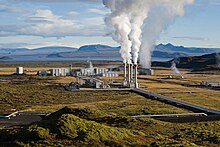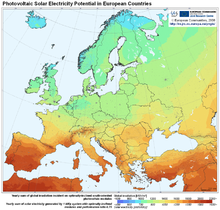Energy in Iceland

The
In 2015, the total electricity consumption in Iceland was 18,798 GWh. Renewable energy provided almost 100% of production, with 75% coming from hydropower and 24% from geothermal power.[4] Only two islands, Grímsey and Flatey, are not connected to the national grid and so rely primarily on diesel generators for electricity.[4] Most of the hydropower plants are owned by Landsvirkjun (the National Power Company) which is the main supplier of electricity in Iceland.[5] Landsvirkjun produces 12,469 GWh which is 75% of the total electricity production in Iceland.[4]
The main use of geothermal energy is for
Iceland is the world's largest green energy producer per capita and largest electricity producer per capita, with approximately 55,000 kWh per person per year. In comparison, the EU average is less than 6,000 kWh.
Energy resources

Sources

Gas
In 1905 a power plant was set up in Hafnarfjörður. Reykjavík wanted to copy their success, so they appointed Thor Jenssen to run and build a gas station, Gasstöð Reykjavíkur. Jenssen could not get a loan to finance the project so a deal was made with Carl Francke to build and run the station, with options for the city to buy him out. Construction started in 1909 and the station was fully built in 1910. The station lit up 120 gas lamps around the city and gave the opportunity to cook with gas too. In 1921 a hydropower plant was built at Elliðarár, which handled the growth of the city. In 1958 the gas station was demolished.[10]
Hydropower
The first
This trend continued and increases in the production of
Other hydroelectric power stations in Iceland include: Blöndustöð (150 MW), Búrfellsstöð (270 MW), Hrauneyjafosstöð (210 MW), Laxárstöðvar (28 MW), Sigöldustöð (150 MW), Sogsstöðvar (89 MW), Sultartangastöð (120 MW), and Vatnsfellsstöð (90 MW).[15]
Iceland is the first country in the world to create an economy generated through industries fueled by
Geothermal power

For centuries, the
Currently geothermal power heats 89%[8] of the houses in Iceland, and over 54% of the primary energy used in Iceland comes from geothermal sources. Geothermal power is used for many things in Iceland. 57.4% of the energy is used for space heat, 25% is used for electricity, and the remaining amount is used in many miscellaneous areas such as swimming pools, fish farms, and greenhouses.[8]
The government of Iceland has played a major role in the advancement of geothermal energy. In the 1940s the State Electricity Authority was started by the government in order to increase the knowledge of geothermal resources and the utilization of geothermal power in Iceland. The agency's name was later changed to the National Energy Authority (Orkustofnun) in 1967. This agency has been very successful and has made it economically viable to use geothermal energy as a source for heating in many different areas throughout the country. Geothermal power has been so successful that the government no longer has to lead the research in this field because it has been taken over by the geothermal industries.[8]
Geothermal power plants in Iceland include
The Icelandic government also believes that there are many more untapped geothermal sources throughout the country, estimating that over 20 TWh per year of unharnessed geothermal energy is available. This is about 3.3% of the 600TWh per year of electricity used in Germany. Combined with the unharnessed feasible hydropower, tapping these sources to their full extent would provide Iceland another 50 TWh of energy per year, all from renewable sources.[14]
Iceland's abundant geothermal energy has also enabled renewable energy initiatives, such as Carbon Recycling International's carbon dioxide to methanol fuel process, which could help reduce Iceland's dependence on fossil fuels.[16]
Solar power
 Source: NREL[17] |
 |
Iceland has relatively low
Wind power
There is an ongoing project in checking the feasibility of a wind farm in Iceland. In 2012, two wind turbines were installed in South Iceland and in 2015 a wind atlas, named icewind, was completed.[18]
Becoming carbon neutral
Iceland is moving towards
According to a 2019 study in the northern Icelandic municipality of Akureyri, low carbon transition will be effective by integrating disconnected carbon flows and establishing intermediary organisations.[22] Reykjavík aims to be carbon neutral by 2040.[23][24] In 2023 a plant using Carbfix technology, an Icelandic invention, will store up to 3 million tons of carbon dioxide in rock, with most of it being imported.[25] In April 2023 it was projected that Iceland will reduce their carbon footprint by 24-26% by 2030, falling short both on their Paris Agreement goal of 29% reduction by 2030 and their personal goal of 55% reduction by 2030.[26] In May 2023 the president of the European Commission and the Icelandic prime minister agreed on a carbon dioxide quota for airplanes in Icelandic airspace until 2026. This was in response to an EU regulation of limiting airplane emissions, that would have affected Iceland. The deal will need approval from the EU and the Icelandic parliament before taking effect.[27]
Experiments with hydrogen as a fuel
In the early 2000s, the viability of hydrogen as a fuel source was considered, and whether Iceland's small population, small scale of the country's infrastructure, and access to natural energy would ease a transition from oil to hydrogen.
ECTOS Hydrogen demonstration project

The
From January 2006 to January 2007 testing of hydrogen buses continued as part of the HyFLEET:CUTE project, which spanned 10 cities in Europe, China and Australia and was sponsored by the
The country's first
Education and research
Several Icelandic institutions offer education in renewable energy at a university level and research programmes for its advancement:
- University of Iceland in Reykjavík, the country's largest research institution, has a programme in renewable energy[35]
- Keilir, Atlantic center of excellence in Ásbrú, runs a research center in energy sciences.[35]
- Reykjavik University, School of Science and Engineering in Reykjavik, offers M.Sc. studies in renewable energy engineering, policy and science.[36]
- University of Akureyri
- United Nations University - Geothermal Training Programme[37]
Several companies, public and private, are conducting extensive research in the field of renewable energy:
- The National Energy Authority of Iceland is charged with conducting energy research and providing consulting services related to energy development and utilization.
- Landsvirkjun, the national electric company, conducts research in hydro-electric and geothermal power and funds a great deal of related research.
- The Icelandic Energy Portal is an independent information source on the Icelandic energy sector.
- Iceland Geosurvey(ÍSOR) is a public consulting and research institute providing specialist services to the Icelandic power industry, dedicated mainly to geothermal and hydroelectric research.
See also
- Electricity sector in Iceland
- Geothermal power in Iceland
- Economy of Iceland
- Icelandic New Energy
- Reykjavik Geothermal
- Dreamland: A Self-Help Manual for a Frightened Nation
- Renewable energy in Norway
- Renewable energy in Denmark
- Renewable energy by country
References
- ^ National Energy Authority of Iceland (30 June 2020). "Development of electricity production in Iceland" (PDF).
- ^ a b c "The Energy Sector". November 11, 2011.
- ^ "Climate Change". www.government.is. Retrieved 2022-02-28.
- ^ a b c "Government of Iceland | Hydro Power Plants". government.is. Retrieved 2021-10-07.
- ^ "Energy in Iceland". Archived from the original on November 18, 2009.
- ^ "A geothermal leader: The case of Iceland". Atlantic Council. 2018-06-01. Retrieved 2021-10-07.
- ^ "Space Heating". National Energy Authority of Iceland. Retrieved 2021-10-07.
- ^ a b c d e f g h Sveinbjorn Bjornsson, Geothermal Development and Research in Iceland (Ed. Helga Bardadottir. Reykjavik: Gudjon O, 2006)
- ^ "Nettostromerzeugung in Deutschland 2021: Erneuerbare Energien witterungsbedingt schwächer - Fraunhofer ISE". 3 January 2022.
- ^ Gasstöðin hverfur. Lesbók Morgunblaðsins, via Tímarit.is, (27.04.1958), pp. 218-222 (in Icelandic)
- ^ a b "The Hydro and Geothermal History". November 11, 2011.
- ^ a b c 19th World Energy Congress, Sustainable Generation and Utilization of Energy The Case of Iceland (Sydney: 2004)
- ^ Electricity Production Archived 2010-09-13 at the Wayback Machine, Landsvirkjun, accessed 2007-04-19)
- ^ a b c Helga Bardadottir, Energy in Iceland. (Reykjavik: Hja Godjon O, 2004)
- ^ a b "Power Plants". November 10, 2011.
- ^ "Technology". Carbon Recycling International. 2011. Archived from the original on 17 June 2013. Retrieved 11 July 2012.
- ^ "PV Watts". NREL. Retrieved 2012-04-16.[permanent dead link]
- ^ Umtalsverð virkjun vindorku á íslandi framundan. (in Icelandic)
- from the original on 9 November 2019. Retrieved 9 November 2019.
- ^ Nations, United. "Iceland's Sustainable Energy Story: A Model for the World?". United Nations.
- ^ "UNEP Announces Climate Neutral Network | News | SDG Knowledge Hub | IISD". International Institute for Sustainable Development. 21 February 2008. Archived from the original on 9 November 2019. Retrieved 9 November 2019.
- ISSN 2071-1050.
- ^ Bernharðsdóttir, Berghildur Erla (14 September 2016). "Reykjavík Carbon Neutral by 2040". visitreykjavik.is. Archived from the original on 9 November 2019. Retrieved 9 November 2019.
- from the original on 9 November 2019. Retrieved 9 November 2019.
- ^ "Vill skilgreina verkefni Carbfix sem námuvinnslu - RÚV.is". RÚV (in Icelandic). 17 March 2023.
- ^ "Telur von á stórum skrefum í nýrri aðgerðaráætlun í loftslagsmálum - RÚV.is". RÚV (in Icelandic). 19 April 2023.
- ^ "Komust að samkomulagi um losunarheimildir í flugi - RÚV.is". RÚV (in Icelandic). 16 May 2023.
- ^ a b c "Icelandic New Energy". ectos.is. Archived from the original on 2007-09-27. Retrieved 2007-05-02.
- ^ ECTOS - hydrogen buses in Reykjavik Iceland, SU:GRE, published 2007, accessed 2007-05-04 Archived 2007-09-29 at the Wayback Machine
- ^ ECTOS web site Archived 2007-09-27 at the Wayback Machine accessed 2007-05-14
- ^ "HyFLEET:CUTE official web site". Archived from the original on February 24, 2008.
- ^ "Hydrogen-filling station opens ... in Iceland". USA Today. 2003-04-25. Retrieved 2007-05-21.
- ^ Jóhannsson, Jóhann K. (15 June 2018). "Vetnisstöð opnuð aftur við Vesturlandsveg - Vísir". visir.is (in Icelandic). Retrieved 2022-02-28.
- ^ "Vetnisbílar hafa ekki eins greiðan aðgang að orku og aðrir bílar". Félag íslenskra bifreiðaeigenda (in Icelandic). Retrieved 13 June 2023.
- ^ a b "Samið um rannsóknarsetur í orkuvísindum - Vísir". visir.is (in Icelandic). 17 April 2009.
- ^ "Mennta sérfræðinga framtíðarinnar". Morgunblaðið. 24 September 2015. Retrieved 13 June 2023 – via Tímarit.is.
- ^ "Jarðhitaskólinn mikilvægur". www.ruv.is. 21 September 2012. Retrieved 13 June 2023.
Bibliography
- 19th World Energy Congress. Sustainable Generation and Utilization of Energy The Case of Iceland. Sydney: 2004.
- Bardadottir, Helga. Energy in Iceland. Reykjavik: Hja Godjon O, 2004.
- Bjornsson, Sveinbjorn. Geothermal Development and Research in Iceland. Ed. Helga Bardadottir. Reykjavik: Gudjon O, 2006.
External links
- Icelandic Energy Portal
- Renewable Energy in Iceland - Nordic Energy Solutions Archived 2021-02-24 at the Wayback Machine
- Kárahnjúkar hydropower project
- Saving Iceland - direct action movement against heavy industry, large dams and large-scale geothermal exploitation in Iceland
- Orkustofnun - Icelandic National Energy Authority
- Hydrogen in Iceland: Current status and future aspects (Icelandic New Energy, September 2006)
- Energy in Iceland: The Resource, its Utilisation and the Energy Policy (Minister of Industry and Commerce, 2000-01-03)
- Iceland President Grímsson: wind power, clean energy on YouTube - a short talk by Ólafur Ragnar Grímsson
- Geothermal Energy Leaves the Window Open for Iceland's Economy
- "Meet Iceland - a Pioneer in the Use of Renewable Resources". A brochure on renewable energy solutions in Iceland. Touches upon everything from geothermal and hydro, to alternative fuels.

